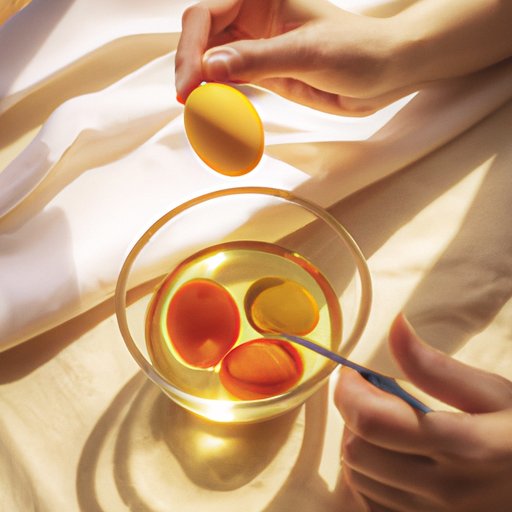
I. Introduction
Easter is a time of joyous celebration, and a long-standing tradition of this season is dyeing eggs. During this time, people of all ages gather together to create vibrant and unique egg designs. If you’re eager to learn how to create colorful eggs with food coloring, then this article is just for you.
Here, we’ll walk you through the step-by-step process of easily and quickly creating egg designs using food coloring. We’ll offer tips and tricks to help you achieve vibrant colors, and show you some creative ways to make your eggs look extra special.
II. Step-by-Step Guide: Dyeing Eggs with Food Coloring
The first step in dyeing eggs with food coloring is to collect all the necessary materials. These include:
- White eggs (hard-boiled or blown out)
- Food coloring
- White vinegar
- Cups, bowls, or containers
- Water
- Spoons or tongs
- Stickers, tape, or rubber bands for making designs
Once you’ve gathered your materials, follow these easy steps:
- Pour one cup of boiling water into a container
- Add 1 teaspoon of white vinegar and food coloring. (More drops will make the color stronger.)
- Stir the solution well
- Place your egg into the mixture with tongs or a spoon
- Leave the egg soaked until you achieve your desired hue
- Remove the egg and pat it dry with a paper towel
- Use a sticker, tape, or rubber band to create designs and repeat the above steps.
III. Fun Easter Activity: DIY Egg Dyeing with Food Coloring
Dyeing eggs with food coloring is a fun, family-friendly Easter activity. Whether you’re dyeing eggs with kids or want to explore your creative side, this activity is fantastic for anyone looking to celebrate Easter in a unique way.
Food coloring is an excellent choice for dyeing eggs, as it is affordable, easily available and comes in eye-catching bright colors. The use of food coloring opens up a world of creativity, and you can create an endless array of designs that will keep kids and adults engaged for hours.
IV. Get Creative with These 5 Unique Ways to Dye Eggs Using Food Coloring
Ready to take your egg dyeing game to the next level? Here are five innovative ways to create unique and stunning designs with food coloring:
- Ombre Eggs: Using a few drops of food coloring and gradually increasing them as you move towards the base, you can create a beautiful ombre effect on your eggs.
- Marbling: Create a unique marbling effect by mixing several colors in a bowl of water and then dipping the eggs in the mix
- Speckled Eggs: Coat the eggs with a single color, then dip an old toothbrush in watered down food coloring and flick the brush onto the egg to create speckles!
- Galaxy Eggs: Create a deep base coat color by soaking eggs for a long time in darker colors. Once dry, use a paintbrush to add stars and detailed lines onto the eggs using white or metallic food coloring.
- Tie-Dye Eggs: Use rubber bands to create stripes, then dip into a food coloring solution where the rubber bands are to create stripes of varying colors.
V. Tips and Tricks for Vibrantly Colored Eggs with just Food Coloring
For a perfect end result, follow these tips and tricks while dyeing your eggs with food coloring:
- Start with white eggs (brown eggs will not give you vibrant colors).
- Use vinegar to create an acidic solution that will help the color stick.
- Place the eggs in the dye mixture while they’re still hot from boiling.
- For more vibrant colors, let the egg soak in the mixture for at least 30 minutes.
- For better handling and to avoid smudging the egg, use tongs instead of your hands.
- Let your creativity run wild when making designs!
VI. Egg Dyeing 101: Using Food Coloring for Beautiful Eggs
The tradition of dyeing eggs was to bring new life and celebration in the spring season. While you can purchase egg dyeing kits these days, food coloring is an inexpensive and more creative option than traditional kits. It also adds an extra bit of fun to a classic craft activity.
VII. Eco-Friendly Easter Eggs: Dyeing with Natural Food Coloring
Using natural food coloring to dye eggs is an excellent way to make your Easter egg decoration eco-friendly. Simply use boiled beets or other edible plant material to make your dye solutions. Here are a few options:
- Yellow: Use turmeric, saffron, or chamomile tea
- Pink: Boil beetroot with water
- Green: Boil spinach or parsley with water
- Orange: Use paprika or chili powder
VIII. Egg-ceptional Decor: How to Use Food Coloring for Stunning Egg Designs
Food coloring can be used for more than just simple egg dyeing- with a little creativity, you can create masterpieces on your eggs. Use a paintbrush, Q-tip or cotton ball to make intricate details on your egg shells with food coloring. Combine different shades of food coloring to make your masterpiece more colorful and eye-catching.
IX. Conclusion
Egg-dyeing has been a favorite Easter family tradition for many years, and it’s easy to see why. With only a few materials, you can create unique and beautiful egg designs. Using food coloring is a fun way to add more creativity and color schemes to this beloved activity. So, gather your supplies, let your inner artiste out and start making breathtaking eggs that will leave your friends and family in awe.




